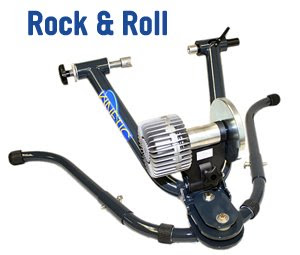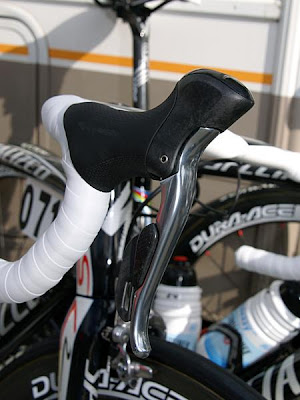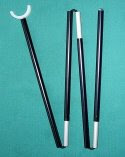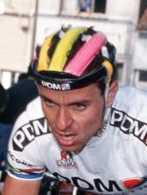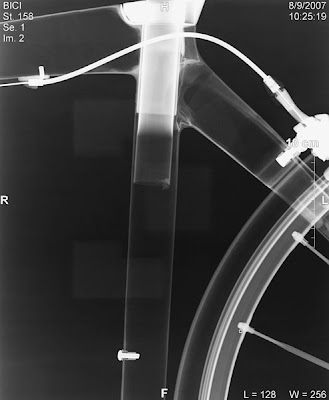It seems to me as if everyone is doing race reports on other blogs and I surely don't want to be left out. I really wanted to be in a state of mind to write about my performances, so I thought that when the BBC (Buffalo Bicycling Club) Giro Series is over, I'll talk about it.
The Giros are circuit races, 30 miles each held on the weekends. It began in early March and ended this past weekend. It was called "Giro della Primavera" sometime back in the past, now its just Giro. Next year, we'll simply call it the 'G', and the year after that, it'll be no more.
They cleverly classify it as a "training race", which is the covering excuse for bunching up all the strong and weak riders alike together in freezing 20 degree weather with no class divisions whatsoever. This egalitarianism is very democratic but when you have a situation like that, it calls for some intense racing on flat (Saturday) and rolling/ hilly (Sunday) roads with plenty of spices and seasonings in the form of repeated surges every 2 minutes, groups splintering all over the place, hill accelerations, and random attacks out of the blue, excuse me, out of the white - since I haven't seen anything around here lately but snow.
This is why I love doing these races. They are classic and TOUGH! Everytime you bend down to get your water bottle, the group in front of you rockets ever more forward into the chilly Buffalo air, destroying your rhythm and dispelling a combination of nose fluid and water bottle remains into the air in the process. If at any time you find yourself dropped, its crucial that you call on the gods of time trialling and yell every prayer you can to stay with the pack. Because if you can't hang on, its going to be a cold, lonely ride to the finish.
Putting such high intensities so early in the season equals some amount of serious pain, but the good side to that is that you can use these races to hone your fitness for something bigger in the weeks and months to come.
Which is what I exactly did.
To get an idea of the magnitude of how interesting this race has been for all of us out here in Buffalo, you must read this neat race report with almost poetic quality from the BBC website. An excerpt :
The morning's misty kiss was still on the pavement as the third episode of the BBC / Handlebars Giro broke free from the surly bonds of earth and vectored ever northward toward the uncharted wastelands of Niagara county. With somewhat decent weather, a stout field in the 20's or so left the shop at the stroke of 10:22, under the clock-steady Latin eye of sometimes Impresario Jim Costello.
After a dawdling warmup that led into a dawdling first few miles a series of attacks signaled the days festivities had begun. A group of series leader Halter, strongman Skalski, the ever present Ryan Nye and three time winner of Witch Weekly's "Handsomest Smile" John Roden were pulling away solidly only to be stopped by a red light, drat. After this regrouping, Jason Skalski took a nice dig, but was welded back by the pack. Halter broke free at that point, dragging Roden who provided limited horsepower and eventually they too were welded back, and so the tedium continued until the start of the final 5 mile loop when a promising group of 5 broke from the pack, containing none of the leaders. After some dawdling in the pack, a chase on the final few miles unfolded with Skalski, Roden, Nye and Ironman Steve Hoad slowing dragging the break back into sight. A final suicidal lunge by Costello closed the gap with 300m to go, setting up the field sprint. Skalski lead the sprint out with team mate Halter glued o his wheel and Roden stuck like chewing gum on a movie seat. Roden's grip slackened and Ben Willis galloped up the right, along with Frank Mesi, paying a visit to the pointy end for the first time all day. Halter tipped his hat to Skalski in the sprint and came off the leadout for his third win in three outings.
Anyway, here's how I did :
15 March : Lockport Circuit
Temperatures : Early 30's (F)
Total Miles - 45
Outcome : Did not complete the final loop. After a long, totally unnecessarily pull energy wise at the front, and with all the repeated surges, I was completely lung-fried with contrastingly numb, icy toes. I quickly faded off the back with some 10 miles to go for a nice solo ride to the finish, with another handy chap who thought he could play HE-MAN riding a fixed gear in a 30mph race. He soon learnt the pain of spinning out of gear and joined me to the finish line.
What I discovered was that not only was I indecently dressed for the weather, I was also not used to the concept of 10 AM punishment-on-bicycle. I'm usually in my BED in sound slumber at that time!!
Hence came a dire need to revise my body clock. Thankfully, all my training has now switched to early mornings, which means I'm the first college student to get out of bed in Buffalo. Sucks....
22 March : Lockport Circuit
Temperatures : Late 20's-30's (F)
Total Miles : 45
Outcome : Did not complete the final loop. I was pretty outstanding at this race too, outstanding as in OUT-OF-THE-PACK off the back in no-man's land. But what I gleaned from this shitty performance was that I was dropped with some 7 miles to go, which means I was able to hang in there for longer. But having taken a wrong turn and riding off the wrong way, I will now remain more committed to GOOGLE MAPS!
I was more rested, chose lighter tires, and wore tight fitting clothes as opposed to being Santa Claus, which I believe saved me some horsepower.
I kept a positive attitude and left content because these are training races in the middle of my BASE period. I'm not supposed to be doing super well, hey! VO2 max training and serious anaerobic building still to come!!!
One of the reasons I couldn't race Sundays was that I had a commitment to go to Church. But on the weekend of the 29th and 30th, I figured that if I go to my friends Church in East Aurora and get out from there earlier, I'll make it to the Marilla Course for the hillier race.
Which is exactly what happened. So I raced on Saturday and Sunday which was good because it almost reached a mini stage-race like proportion.
29 March : Lockport Circuit
Temperatures : 20's with sun (F)
Total Miles : 40
Outcome : Completed the RACE!!! Sweet! For the most part of the race, I stuck to the pack, going with the faster riders and ensuring that I didn't end up too back as to wake up and realize that no one is with me. With about 3 miles to go in the race, that hard last turn to the finishing stretches of Tonawanda Creek Road took a chunk out of my lungs and legs and I decided I didn't have much left to go. The good side is that I finished the race much much stronger than the weeks before and that had me pleased. Fitness is improving.
30 March : Marilla Circuit (Southtowns)
Temperatures : Late 20's with sun (F)
Total Miles - 35
Outcome :
Finished in a chasing mid pack!!! The race on Sunday was certainly a first for me. The course was amazingly simple direction wise but there was a decent amount of climbing to do. My aim was not to stick with the faster riders as I knew that would surely blow me inside out too early, but to be wiser and ride with those at my fitness level. With some two laps to go, I dropped from the main pack like a slipping duck which wasn't due to having tired legs, but I caught the wrong wheel and it was considerably slower. When I realized that, it was too late and the main pack was strongly pulling away.
A handful of riders dropped out and slowed down considerably either because they pushed themselves too hard out in front, were too fat, or their legs were near to toast from the hard racing on the previous day.
For the most part of this ride, I rode with another guy, paying attention closely to the gears suitable for me on the different gradients, watching my eating and drinking, and using another rider to draft off. In the tail wind sections of the course, I could grit my teeth, achieve a very flat back and time trial at 26 mph for 2-3 minutes which I thought was pretty cool. We infact pushed ourselves to go hard enough that we caught up with two more dropped out riders in front of us.
When I finished that race, I had hardly anything left in me and the most joy I got out of it was the fact that I gave everything I had and had a good day.
In short, these were some solid training races for me. I have realized that I have a very good amount of endurance but I will need to step into high intensity workouts, particularly those attacking my LT, Anaerobic Endurance and VO2 max beyond living daylights!
DID YOU KNOW? In France, a
peleton is a pack of bicycle racers out on the road. In Buffalo NY, we call it
bulleton.
What motivates 30+ riders to come out and waste themselves in freezing temperatures, no one knows but this place sure has some hardy men, equally rivaling the Europeans on the eastern side of the Atlantic. I was proud to be a small part of that.


 How CNT Will Make A Difference [Easton]
How CNT Will Make A Difference [Easton]








